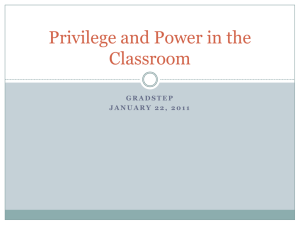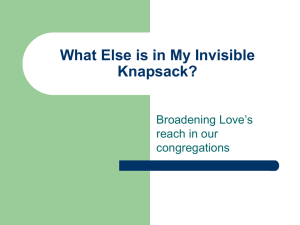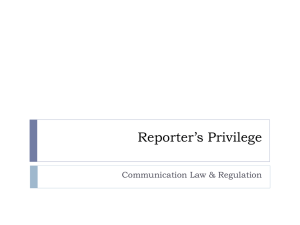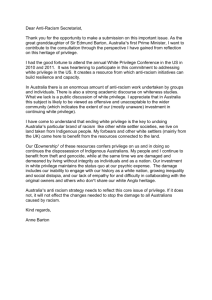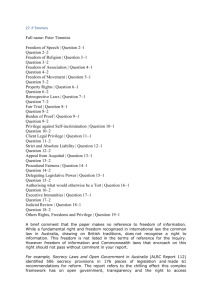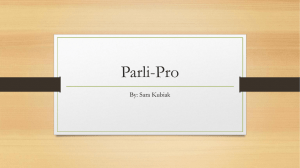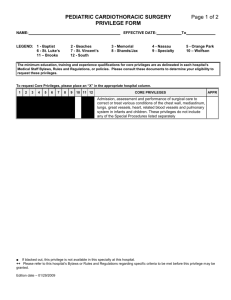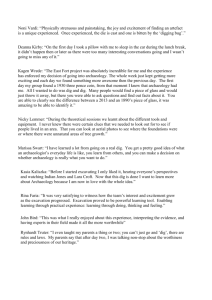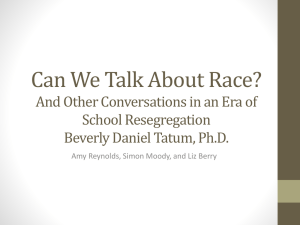Brandi Ballard 4/12/10 First off, I would like to thank the Women`s
advertisement
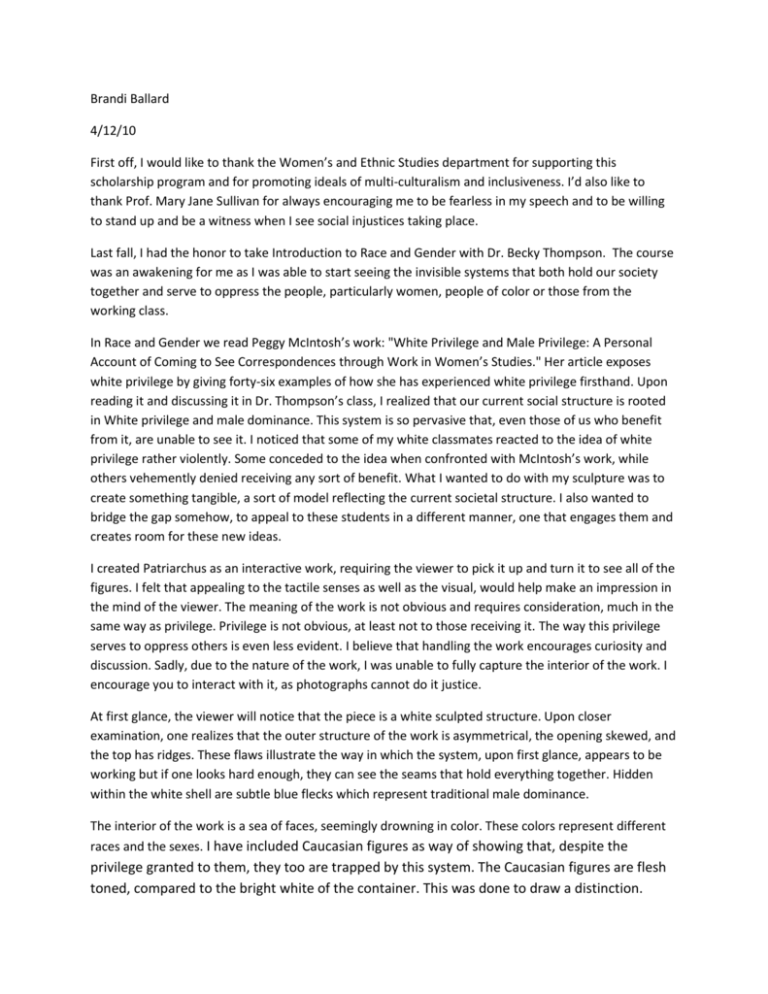
Brandi Ballard 4/12/10 First off, I would like to thank the Women’s and Ethnic Studies department for supporting this scholarship program and for promoting ideals of multi-culturalism and inclusiveness. I’d also like to thank Prof. Mary Jane Sullivan for always encouraging me to be fearless in my speech and to be willing to stand up and be a witness when I see social injustices taking place. Last fall, I had the honor to take Introduction to Race and Gender with Dr. Becky Thompson. The course was an awakening for me as I was able to start seeing the invisible systems that both hold our society together and serve to oppress the people, particularly women, people of color or those from the working class. In Race and Gender we read Peggy McIntosh’s work: "White Privilege and Male Privilege: A Personal Account of Coming to See Correspondences through Work in Women’s Studies." Her article exposes white privilege by giving forty-six examples of how she has experienced white privilege firsthand. Upon reading it and discussing it in Dr. Thompson’s class, I realized that our current social structure is rooted in White privilege and male dominance. This system is so pervasive that, even those of us who benefit from it, are unable to see it. I noticed that some of my white classmates reacted to the idea of white privilege rather violently. Some conceded to the idea when confronted with McIntosh’s work, while others vehemently denied receiving any sort of benefit. What I wanted to do with my sculpture was to create something tangible, a sort of model reflecting the current societal structure. I also wanted to bridge the gap somehow, to appeal to these students in a different manner, one that engages them and creates room for these new ideas. I created Patriarchus as an interactive work, requiring the viewer to pick it up and turn it to see all of the figures. I felt that appealing to the tactile senses as well as the visual, would help make an impression in the mind of the viewer. The meaning of the work is not obvious and requires consideration, much in the same way as privilege. Privilege is not obvious, at least not to those receiving it. The way this privilege serves to oppress others is even less evident. I believe that handling the work encourages curiosity and discussion. Sadly, due to the nature of the work, I was unable to fully capture the interior of the work. I encourage you to interact with it, as photographs cannot do it justice. At first glance, the viewer will notice that the piece is a white sculpted structure. Upon closer examination, one realizes that the outer structure of the work is asymmetrical, the opening skewed, and the top has ridges. These flaws illustrate the way in which the system, upon first glance, appears to be working but if one looks hard enough, they can see the seams that hold everything together. Hidden within the white shell are subtle blue flecks which represent traditional male dominance. The interior of the work is a sea of faces, seemingly drowning in color. These colors represent different races and the sexes. I have included Caucasian figures as way of showing that, despite the privilege granted to them, they too are trapped by this system. The Caucasian figures are flesh toned, compared to the bright white of the container. This was done to draw a distinction. Although white people may benefit, not all of us are participating willingly in this system. There is a difference between being white and White (with a capital W), the former simply being a skin tone and the latter meaning that one contributes to and sustains the current patriarchal system. In creating this work, I realized how difficult it is to take the concept of our societal structure and translate it into something tangible. Learning about these hidden seams prompted a sort of investigation for me. I began to see the intersections between class, race, gender, and sexuality in my own life. I began to become aware of systems of oppression. The more I discovered, the further I wanted take my studies. This is why I decided to major in Women’s and Ethnic Studies. My hope is that the viewer is similarly intrigued. I want him or her to look at Patriarchus as a sort of puzzle. I hope the first question one would ask is “what is this white structure that contains all of these people.” There are many layers of meaning hidden within the work. For instance, the oculus can be seen as the narrow opening through which the oppressed can only look through, but also as a way out, as hope for equal opportunity and inclusiveness. I’d like to think that the viewer, even after walking away from the work, will continue to have realizations as it unfolds to them. In this way, the work moves from representational art into an experience. Thank you. I’d like to read a poem that I wrote in another of Dr. Thompson’s classes last semester. It is a response to Martin Espada’s “The Meaning of the Shovel” from Imagine the Angels of Bread. For me, art in its many forms is an effective vehicle for protest, for bridging the gaps between us and creating understanding and community. My poem is an attempt to understand why I dig, why I’ve decided to search for truth and expose it, whether it is in social justice poetry, art, fearless speech or other mediums. I DIG BECAUSE I dig because I have to believe there is something worthwhile in myself. I dig because others can’t, whether their backs are bent and frail or they don’t have access to a shovel. I dig because a bean field is more beautiful than the graves of our soldiers in a meaningless war. I dig because I am haunted, the world’s guilt rests on my shoulders and only through backbreaking labor am I able to shrug it off. I dig because I value truth over lies. My shovel, my pen, my tongue, they are all tools for digging, for unearthing truths entombed in soil. In the light they harden and gain permanence. I hope that I might have, in some small way, made the truth more accessible through my work and through speaking here today. Thank you.
